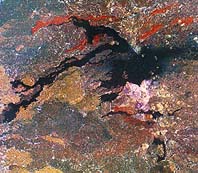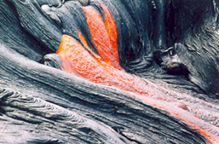
 Volumetrically, most lava
is of basaltic composition. Basaltic
melts have overall lower gas contents and are more fluid than
their andesitic-to-rhyolitic counterparts. Their higher
fluidity (lower viscosity) is a product of their lower SiO2 (silica) contents. When gases exsolve
from basaltic melts they are allowed to rise unimpeded through
the fluid magma without a significant build up of gas pressure.
This results in relatively calm, nonexplosive eruptions, and a
preponderance of lava. In contrast, when gases exsolve from felsic magmas, their upward
mobility is impeded by the high viscosity of the melt. This results
in the buildup of gas pressure, which generates explosive eruptions
associated with a preponderance of pyroclastic ejecta. The low
viscosity of basaltic lavas allows them to be extruded over great
distances, often producing high-volume lava flows with low aspect
ratios (ratio of thickness to area). Under the right conditions,
de-gassed felsic magmas can also erupt lava in a nonviolent manner.
However, felsic lavas tend to be much thicker than basaltic lavas
and have much higher aspect ratios.
Volumetrically, most lava
is of basaltic composition. Basaltic
melts have overall lower gas contents and are more fluid than
their andesitic-to-rhyolitic counterparts. Their higher
fluidity (lower viscosity) is a product of their lower SiO2 (silica) contents. When gases exsolve
from basaltic melts they are allowed to rise unimpeded through
the fluid magma without a significant build up of gas pressure.
This results in relatively calm, nonexplosive eruptions, and a
preponderance of lava. In contrast, when gases exsolve from felsic magmas, their upward
mobility is impeded by the high viscosity of the melt. This results
in the buildup of gas pressure, which generates explosive eruptions
associated with a preponderance of pyroclastic ejecta. The low
viscosity of basaltic lavas allows them to be extruded over great
distances, often producing high-volume lava flows with low aspect
ratios (ratio of thickness to area). Under the right conditions,
de-gassed felsic magmas can also erupt lava in a nonviolent manner.
However, felsic lavas tend to be much thicker than basaltic lavas
and have much higher aspect ratios.
The volume of magma generated over a given amount of time is known as the effusion rate. The effusion rates for historical eruptions of basaltic lava are highly variable, from 0.5 to 5000 m3/sec. Historic flows from Mt. Etna average about 0.5 m3/sec, whereas the fissure-generated flows associated with the Icelandic Laki eruption in 1783 were released at a rate of ~5000 m3/sec. The effusion rates for andesite and dacite are much lower (~10 to 0.05 m3/sec) due to their higher viscosities.
 Red hot lava in action. Here, on the Kilauea shield volcano, two lava springs have broken through solidified lava crust on top of a lava tube; each is about one meter wide. Note the development of ropes in the forground. Photo curtesy of Hetu Sheth, August, 2002. |
Lava is highly variable in composition and it therefore varies greatly in flow character. Once crystallized, this compositional diversity is reflected in variations in rock texture, mineralogy, and volcanic landforms. Click on the links below for a more detailed description of the compositional lava types: |